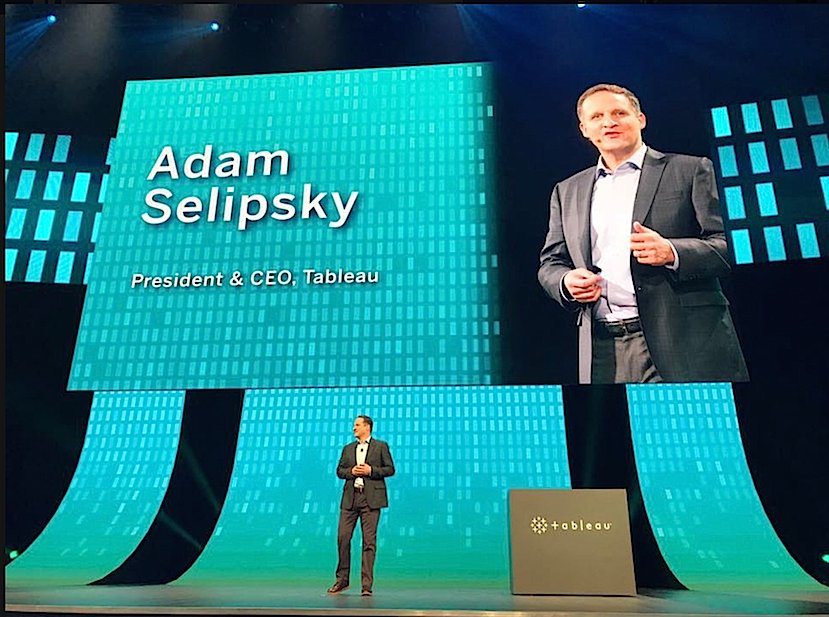 BIG DATA
BIG DATA
 BIG DATA
BIG DATA
 BIG DATA
BIG DATA
Tableau Software Inc. today provided the strongest evidence yet that its shift from a software license model to subscription pricing is bearing fruit.
Its first-quarter revenue of $224 million beat Wall Street’s estimates as well as the company’s own guidance, sending shares up nearly 7 percent in after-hours trading.
Although Tableau’s net loss per share of 19 cents was slightly below analyst estimates, investors were clearly focused on other things, most notably a 46 percent jump in annualized recurring revenue, or ARR, to $642 million, from a year earlier. Growth was fueled by a surge in subscription ARR, which shot up 230 percent, to $237.5 million.
The Seattle-based company, which provides data visualization tools for enterprises, has been on a two-year campaign to shift from its longtime reliance upon a software license model to one based on subscriptions. Software subscriptions are considered a win-win proposition because they lower customer acquisition costs while also giving vendors more predictable revenue streams. The transition can be rocky, however, since large contracts atomize into smaller monthly payments.
Tableau botched the first stages of the shift, reporting an earnings surprise that triggered a 50 percent one-day drop in the price of its shares in early 2016. The stock has crawled back steadily since then, and now stands slightly above the preplunge level, but it’s still a third below the all-time high the company enjoyed when it was a data analytics darling.
Tableau introduced subscription pricing about a year ago, and executives said customers have responded enthusiastically. “We’re continuing to go through this subscription transition faster than expected,” said Adam Selipsky (pictured), who joined the firm as chief executive in mid-2016. “We’ve been on a journey to make it easier for customers to buy and deploy Tableau. The next stage is to make it easier for customers not just to buy Tableau to but to scale as well.”
To that end, the company has been on a campaign to boost the power and performance of its core visualization platform — which it did in January — as well as to shake its image as a one-trick pony. Earlier this year, it introduced new subscription offerings for the Tableau Creator, Explorer and Viewer products, which are oriented toward a wide range of users from data scientists to casual viewers.
Last month, it stepped into the data preparation market with an offering dedicated to helping customers integrate and transform source data. “Tailoring our platform to enable more people to interact with data creates more opportunities for organizations to standardize on Tableau,” said Selipsky.
Although Tableau has come under new competition from the likes of Microsoft Corp.’s PowerBI and the richly funded startup Looker Data Sciences Inc., it’s still considered the king of hill in a market it largely invented. And it’s showing consistent growth again.
The company said it expects full-year revenue of between $950 million and $985 million, up about 10 percent. “All of our [key performance indicators] — revenue, ARR, customer growth and customers who spent more than $1 million in the quarter – showed strength,” Selipsky said.
Insight Guru Inc., a maker of stock-price forecasting tools that does business as Trefis, agreed. In a group-authored Forbes post, it wrote, “The company’s customer base has increased strongly… to around 70,000 in Q4, With Tableau’s announcement of the deployment of Tableau Online using Amazon Web Services, a strategic partnership with Google, and a revised pricing structure leading to reduced upfront costs for its customers, we expect increased adoption of the company’s products.”
Today’s news indicates they might be right.
Support our mission to keep content open and free by engaging with theCUBE community. Join theCUBE’s Alumni Trust Network, where technology leaders connect, share intelligence and create opportunities.
Founded by tech visionaries John Furrier and Dave Vellante, SiliconANGLE Media has built a dynamic ecosystem of industry-leading digital media brands that reach 15+ million elite tech professionals. Our new proprietary theCUBE AI Video Cloud is breaking ground in audience interaction, leveraging theCUBEai.com neural network to help technology companies make data-driven decisions and stay at the forefront of industry conversations.